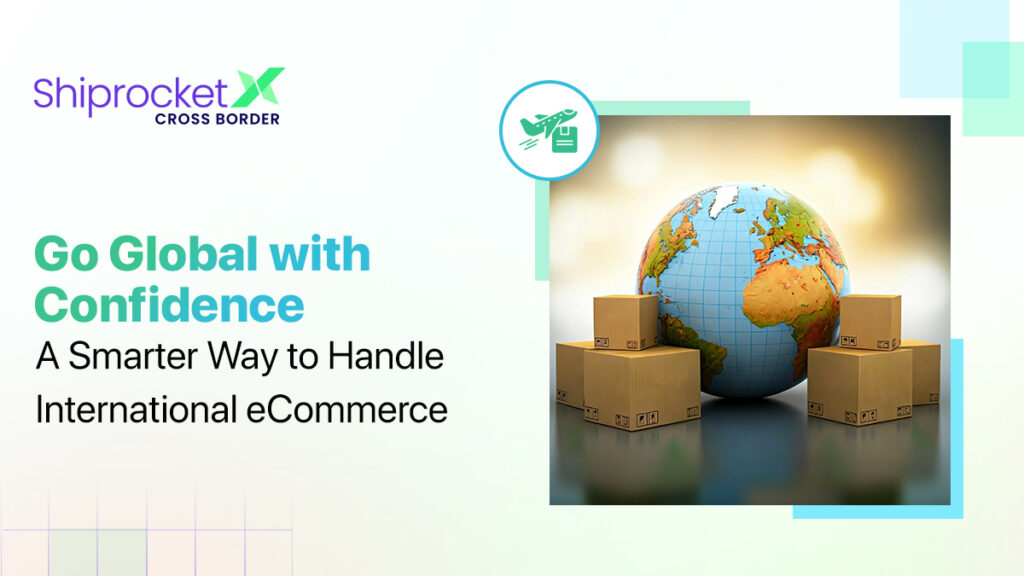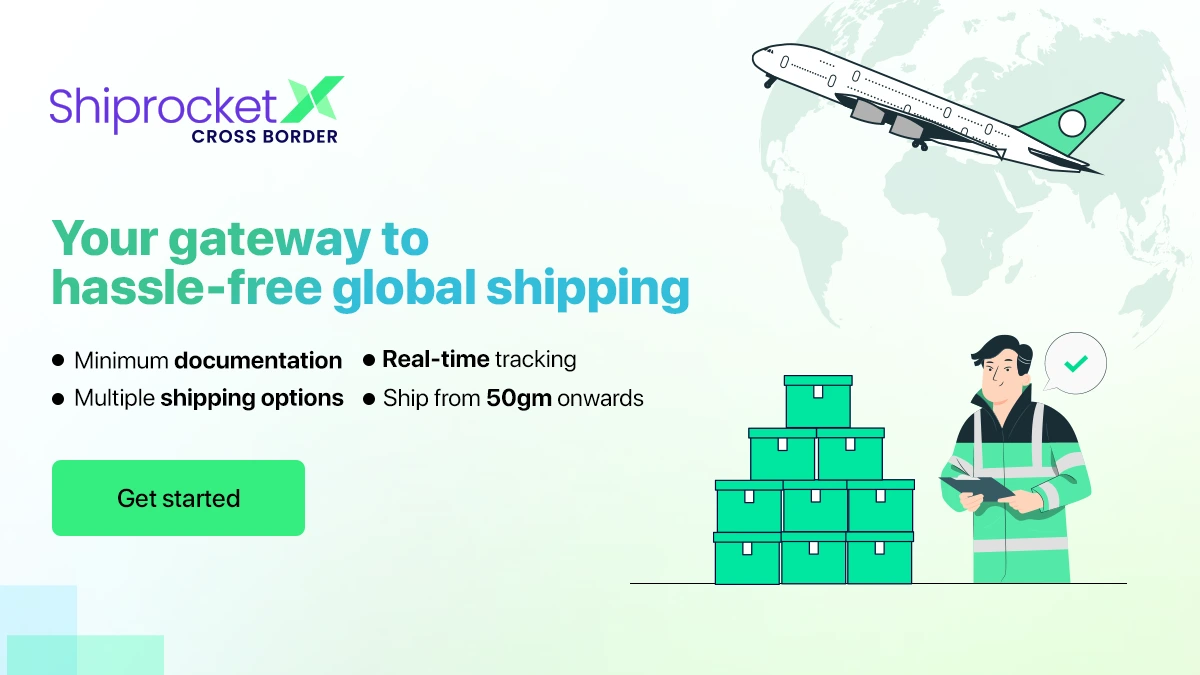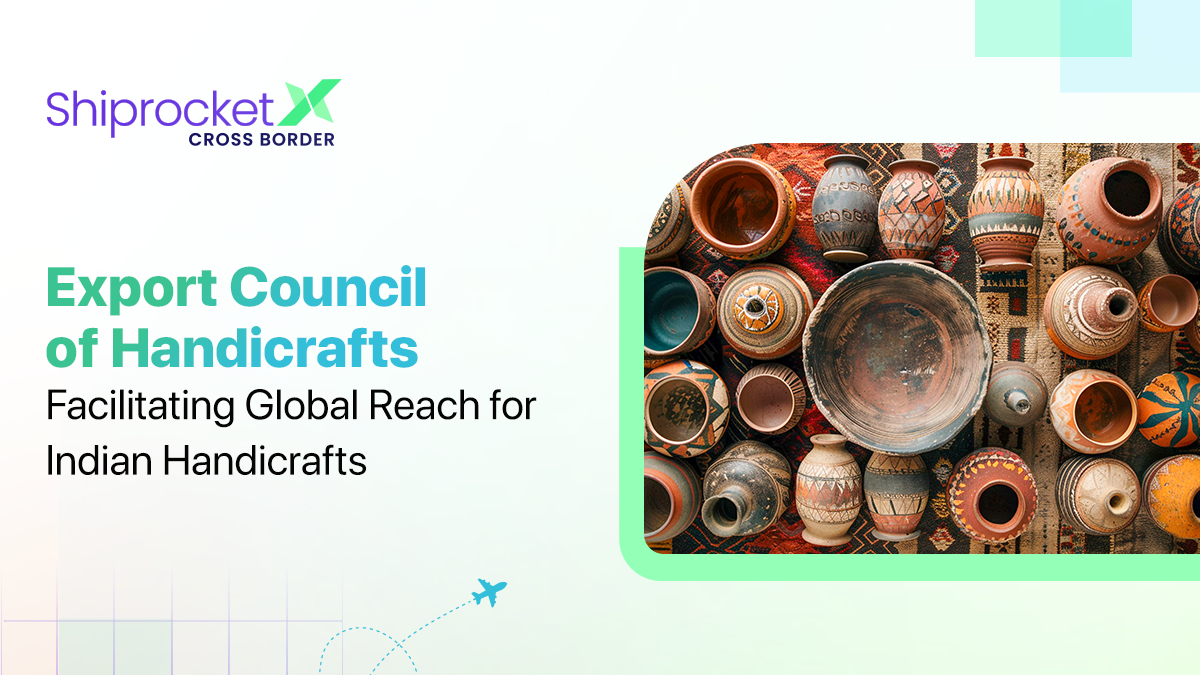What Is International eCommerce and How It Works?
- Why Does Customer Experience Matter in Global Shipping?
- What Are the Benefits of Reaching International Customers?
- What Are the Common Global Shipping Issues and Solutions?
- Which Cost Factors Affect Overseas Shipping the Most?
- What Cross-Border Fulfillment Models Work Best?
- What Shipping Trends Are Shaping International eCommerce in 2025?
- What Proven Tips Can Ensure Reliable Global Shipping?
- How ShiprocketX Simplifies Cross-Border eCommerce for Indian Sellers?
- Conclusion
International eCommerce means selling products online across country borders. It allows businesses to reach global customers through online platforms instead of being limited to local markets. International eCommerce is growing fast, opening up new ways for sellers like you to reach customers across the world. But shipping for international eCommerce isn’t always easy. Customs delays, high costs, or delivery issues can hold you back if there’s no clear plan. With the global cross-border eCommerce market expected to reach USD 4.8 trillion by 2032, the potential is huge. But to grow smoothly, you’ll need the right shipping strategies in place.
This guide will walk you through simple, practical tips and tools to help you ship smarter and take your business global without unnecessary hurdles.

Why Does Customer Experience Matter in Global Shipping?
If you’re selling to customers outside India, international eCommerce shipping is what gets your product from your store to their doorstep. It sounds like a long process, but once you understand the steps, it becomes easier to manage and helps you expand to new markets without confusion or delays. To make the process simpler, here are five key stages you need to focus on:
1. Planning and Preparation: Start by identifying where there’s demand for your product. Then, look into shipping costs, delivery time, and whether the carriers in that country are reliable. Before you start shipping, you should also know the import rules, taxes, and customs clearance processes of the country you’re targeting.
2. Choosing the Right Shipping and Paperwork: Decide how you want to ship, by courier, air, or sea, based on whether you prefer speed or cost. Always keep all relevant documents ready, such as invoices, shipping labels, packing lists, and certificates, as missing one can delay the entire process. You can try automating these tasks if possible and tie up with a reliable courier or third-party logistics provider to simplify this process
3. Order Processing and Dispatch: Once an order is received, verify that the product is in stock and the buyer’s details are accurate. Then, pack the order securely, label it properly, and hand it over to the shipping partner. Ensure the tracking link is working so the customer knows exactly where their order is.
4. Customs and Delivery: Your package will undergo customs clearance in both India and the destination country. If all the paperwork is correct, this part is usually smooth. After clearance, it is shipped via the chosen route, whether air, sea, or road, and reaches the buyer on time.
5. Customer Experience Matters: Inform the buyer of all relevant details before they place the order, including shipping fees, delivery time, and any applicable customs duties. If you’re selling in multiple countries, ensure your website uses the correct language, currency, and formatting.
What Are the Benefits of Reaching International Customers?
If you’re selling online, reaching customers in other countries can really help your business grow. You’re not just depending on the local market anymore. You’re opening doors to bigger opportunities. Here’s why going global is worth it:
- More Customers, More Sales: Once you start selling internationally, your buyer base increases. You get more orders and more chances to grow.
- Better Profit Margins: In many countries, customers are willing to pay higher prices. That means more profit for the same product.
- Stronger Brand Image: When your brand is seen globally, it builds more trust. It makes your business appear larger and more credible.
- Room to Grow: Some products do better abroad than they do locally. That gives you new ways to expand and test different ideas.
- More Loyal Customers: Global buyers value good service. If they’re happy, they’ll return, and maybe even recommend you to others.
- Stronger Position in the Market: When you already sell internationally, it’s easier to enter new markets. You stay ahead of others who haven’t taken that step yet.
What Are the Common Global Shipping Issues and Solutions?
There are several common problems that most sellers encounter. Some are small, others can be serious. But all of them can be fixed with the right steps.
Here are the most common global shipping problems—and how to deal with them:
- Rising Shipping Costs: Fuel rates go up, container space gets tight, and suddenly you’re paying more to ship the same item. It’s a good idea to compare prices often. Sending bulk shipments can also save money.
- Delivery Delays: Sometimes packages get stuck at ports, or customs take too long. Sometimes it’s just bad weather. You can’t stop it, but you can send early and pick partners who’re known to deliver on time.
- Damaged or Lost Items: This usually happens when the packaging isn’t strong enough. Using good-quality boxes, extra padding, and clear labels can make a big difference.
- Not Enough Visibility: If you don’t know where your shipment is, you can’t answer your customer. Using tracking tools helps both you and the buyer stay updated.
- Customs and Regulation Issues: Every country has its own rules. Even a small mistake in paperwork can delay your shipment. Double-check documents before shipping and stay informed about any changes.
- Cybersecurity Concerns: Everything is digital now. Hackers can target your shipping data. Always use trusted software and keep your systems secure.
- Sustainability Pressure: Customers are increasingly aware of packaging waste and carbon emissions. Using eco-friendly packaging and cleaner delivery options can help your brand look more responsible.
Which Cost Factors Affect Overseas Shipping the Most?
If you’re sending products overseas, shipping costs can catch you off guard. There are a few things that really affect how much you end up paying. These aren’t hard to understand, but they can easily be missed if you’re new to it. Some of the factors that need your consideration and decide your costing are:
- Distance and Route: The farther your shipment has to go, the more it’ll cost. Some routes also cost more just because they pass through busy or high-charge areas. You don’t always have control over this, but you can compare route options to find better rates.
- Weight and Size: Heavier or bulkier packages cost more to ship. Especially with air freight, every extra kilo adds up fast. Trying to pack smart, smaller, and lighter boxes can save a lot.
- Customs and Duties: Every country has its own rules for imports. If you’re not aware of the local taxes or paperwork, you could face delays or extra charges. It’s helpful to review these before sending anything out.
- Insurance and Tracking: If you’re shipping something valuable, it’s smart to insure it. Some carriers include it, others charge extra, but it’s usually worth it.
- Other Hidden Charges: Fuel prices change, and sometimes you’ll see fuel surcharges added to your bill. Ports can also charge handling fees. And if your payment is in a currency other than the one you use, exchange rates may affect your profit.
What Cross-Border Fulfillment Models Work Best?
If you are planning to sell globally, these are the main models you can consider:
1. Ship Directly from India (Centralised Fulfillment)
This is the most basic way. You keep your stock here and ship every international order from India. It’s a good starting point if you’re new to selling globally. You won’t need much setup. However, delivery takes longer, and international shipping can be more expensive for both you and the buyer.
2. Local Fulfillment in Target Countries (Decentralised Fulfillment)
This is when you send bulk stock to a warehouse in the country where most of your buyers are. So when an order comes in, it’s packed and shipped from that warehouse. It saves time and shipping costs, but you’ll need to manage more inventory and spend more to set it up.
3. Use a Mixed Model
You do not have to choose just one. The things that sell quickly are kept in local warehouses, although many vendors still ship specific products from India. It’s a risk-free approach to see how things go before diving in.
What Shipping Trends Are Shaping International eCommerce in 2025?
Here’s what’s happening in shipping in international eCommerce in 2025 and what it means for your business:
- Smart Tools Are Taking Over the Heavy Lifting: Shipping doesn’t have to take up all your time anymore. AI-based tools can pick couriers, print labels, manage orders, and even suggest prices. It reduces your workload and allows you to focus on selling.
- Eco-friendly Practices: Customers now notice if you’re using too much plastic or unnecessary boxes. Switching to simple, recyclable packaging doesn’t just help the environment, it makes your brand look responsible and modern.
- Packaging Matters: The moment a buyer opens a box matters more than you think. A neat, branded packaging conveys a sense of premium quality. Many buyers even post unboxing videos, so what you send is also part of your marketing.
- Drones and Smart Delivery Vans are Becoming Real: What feels like future tech is slowly entering real-life deliveries. Some sellers are already testing drone drops and self-driving vans in select areas. It’s still early, but it’s coming faster than expected.
What Proven Tips Can Ensure Reliable Global Shipping?
Let us take a look at some tips that can help your business in international shipping:
1. Take Packing Seriously: Use high-quality boxes, provide additional cushioning, and properly wrap everything. A faulty box or a loose label may cause the delivery to fail.
2. Double-check Your Documents: Pay attention to every document. If a document is missing from your package, Customs will keep it. Always include a clean invoice, product details, and any country-specific documentation.
3. Work With the Right Courier: Not all shipping partners are suitable for overseas orders. Choose one that provides good tracking and assistance.
4. Know the Rules: Rules differ from one nation to another. Some items may be subject to taxation or regulation. It is good to find out this beforehand.
5. Track Everything: Use a tool that tells you the package’s location at each stage. And for costly items, always get insurance; it saves you if anything goes wrong.
How ShiprocketX Simplifies Cross-Border eCommerce for Indian Sellers?
Taking your business global comes with many challenges, especially when it comes to shipping. ShiprocketX simplifies international order fulfillment by helping Indian sellers deliver to over 220 countries without the usual complexities.
The platform offers a range of delivery schedules, from standard to expedited, allowing orders to be fulfilled according to the buyer’s preferences. Effective management of all customs clearance, documentation, and shipping processes reduces the risk of delays or missing goods.
Sellers receive a centralised dashboard to manage international orders, returns, and tracking in one place. Buyers get real-time updates through email and WhatsApp, which helps build trust and improves the post-purchase experience. With branded tracking, transparent pricing, and dedicated support, ShiprocketX ensures a smoother, more reliable system for global sellers.
Conclusion
Getting shipping for international eCommerce right doesn’t have to be complicated. It just needs to work well. If your orders arrive on time, your packaging is neat, and your shipping costs are clear, buyers will trust you, even if they’re thousands of miles away. That’s what really matters.
As more people shop across borders, it’s a good time to fine-tune how you ship. Use reliable partners, stay on top of rules, and don’t overpromise on delivery times. When your shipping runs smoothly, customers notice, and they’re more likely to buy from you again.
In a world without borders, smart shipping is your passport to global success.





